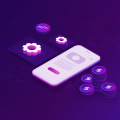Mobile Application Development Trend: A Sneak Peak into Each Development Phase

It is always recommended to work on business growth on all levels, irrespective of the position. Whether you rely on your own resource or focus on outsourcing, you must always take an initiative to step the game up for your business.
So, how can make improvements to your business?
Now, whether you are planning for long or you have just started thinking about it, the answer in either case is about making an investment in the mobile application.
As for mobile development, many businesses make a mistake thinking that it’s all about choosing the app design, picking the right programming language, doing quick testing and submitting to the app store and it’s done.
Unfortunately, it’s not that easy. While a sizeable amount of the mobile data traffic is generated from the mobile application, it is vital to follow the entire life span of mobile app development to lure the broad user base.
Needless to say, building an application is indeed a daunting task. Instead, sugar-coating the process, let’s delve deep into the Mobile App Development Lifecycle.
The Typical Mobile App Development Lifecycle:
Phase1: Determine Your Business Goals:
Before jumping to app development, it is important to have a clear perception about what you want to achieve through an app. Ask yourself what you want to do with the app. Is building this application beneficial for your business? Who is your target audience?
You may have other questions pop into your mind. But, these are fundamental questions that can help you have an idea of how you want your app to be like. Making an app for the sake of having an application makes no sense. There are already millions of applications flooded in the app store. So, be aware of your intent before you go for having an app.
Phase 2: Wireframing and Prototyping of the App:
Post planning, you need to focus on the app design. During the design phase, be certain to highlight two important aspects of the app: User Interface and User Experience.
User Interface means how your application works. On the other hand,
User Interface means the graphical and touch-sensitive display on a mobile device, that allows the user to interact with the device’s apps, features, content, and function, whereas UX refers to the overall experience of the users. To improve the user experience, the most straightforward approach is Wireframing. It is nothing but a rough draft of the application that enables the end-user to understand how it is going to look like. The best part of adopting this approach is that it offers incredibly flexible tools and more like sticky notes that make it easy for end-users to customize the look and feel of the app they find fit for their business.
Hire android developer and quickly prototype the idea of the app into a practical model to see how it functions in reality.
Phase 3: Code the Application:
Coding is a crucial part of any mobile app development. The whole idea of coding requires certain level of skills and technicalities. As you step into the programming phase, make sure all the focus will be on coding to develop an error-free app.
If you wish to get professional assistance, hire android developers who are readily available out there in the market. They are knowledgeable and well-skilled; therefore, they can help you develop an application for your business goals. Their knowledge and experience with the mobile app development allow them to create the best app that enables end-users to reach their target audience easily and quickly.
Take a Test Drive:
So, you must be very excited. Your app is almost ready to be launched. But, don’t make the mistake of introducing into the market without testing. Testing is one of the most critical phases as it helps identify any flaws in the apps. Thus, it allows you to further work on it until it runs smooth. Hire android programmer to test the app and locate the bugs from the user point of view.
Other articles and publications:
Articles and publications of other companies:
- +1 (619) 331-2970
- 548 Market St San Francisco, CA 94104
- www.capitalnumbers.com










